Introduction
Euschistus quadrator Rolston was described in 1974, with specimens from Mexico, Texas, and Louisiana. Euschistus quadrator was not found in Florida until 1992. It has since spread throughout the state as well as becoming an agricultural pest of many fruit, vegetable, and nut crops in the southeastern United States. It has a wide host range, but is most commonly found in cotton, soybean and corn. Euschistus quadrator has recently become a more prominent pest with the introduction of crops such as Bt cotton and an increase in the usage of biorational or reduced-risk pesticides.
Distribution
Euschistus quadrator is originally from Texas and Mexico, and has since been reported in Louisiana, Georgia, and Florida.
Description
Adults
The adults are shield-shaped and light to dark brown in color. They are smaller than many other members of the genus, generally less than 11 mm in length and approximately 5 mm wide across the abdomen. They are similar in size to Euschistus obscurus. Euschistus quadrator lacks dark spots in the membranous area of the hemelytra, a characteristic present in other Euschistus species.
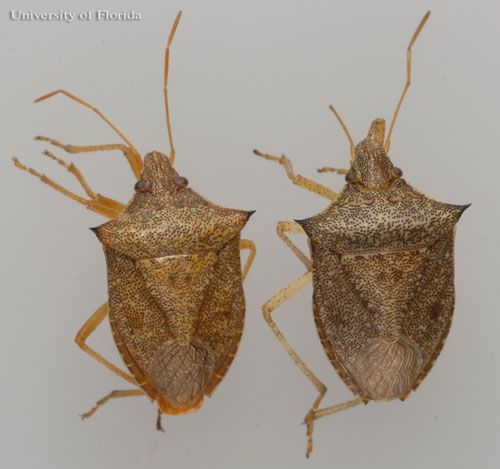
Credit: Lyle Buss, University of Florida
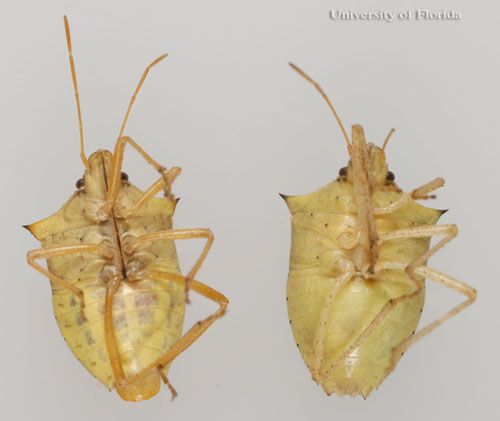
Credit: Lyle Buss, University of Florida
Eggs
Euschistus quadrator eggs are initially semi-translucent and light yellow, and change color to red as the eggs mature. The micropylar processes (fan-like projections around the top of the egg) are longest in this species compared with other Euschistus spp.
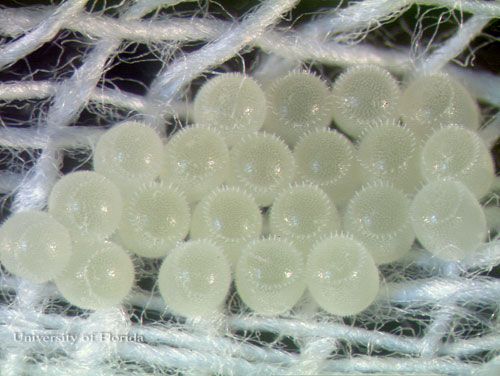
Credit: Sara Brennan, University of Florida

Credit: Sara Brennan, University of Florida
Nymphs
There are five nymphal instars, varying in color and size. More research is being conducted to determine color and size variation within instars.
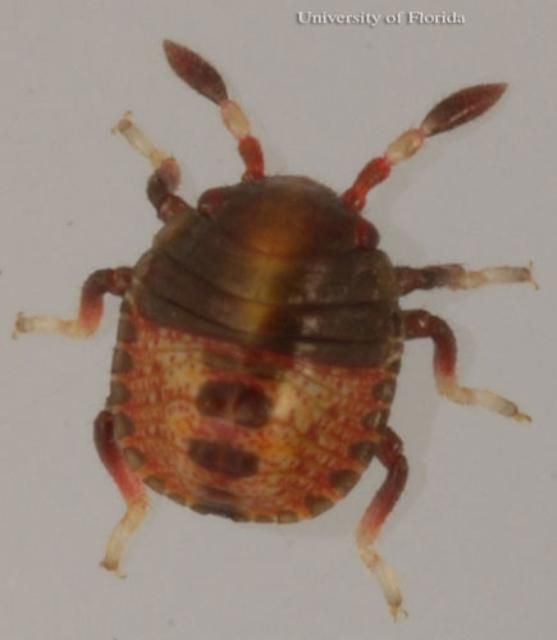
Credit: Lyle Buss, University of Florida
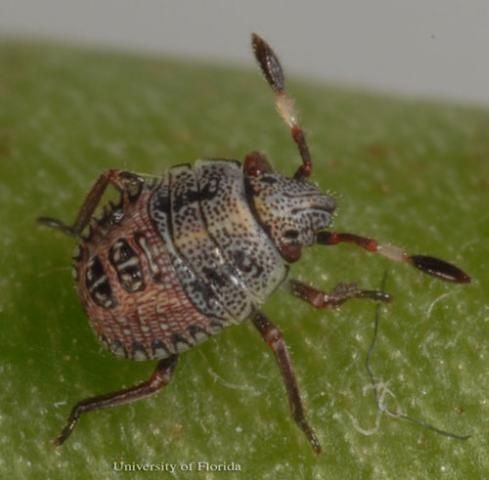
Credit: Lyle Buss, University of Florida
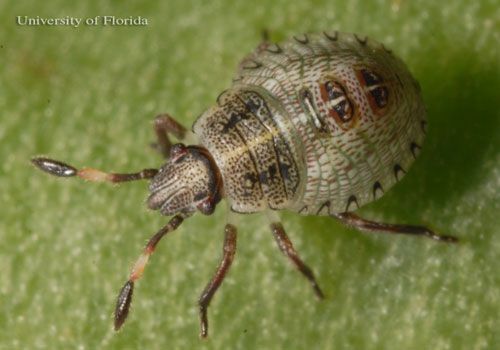
Credit: Lyle Buss, University of Florida
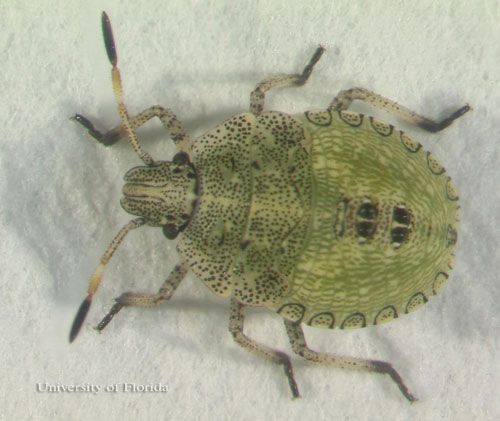
Credit: Lyle Buss, University of Florida
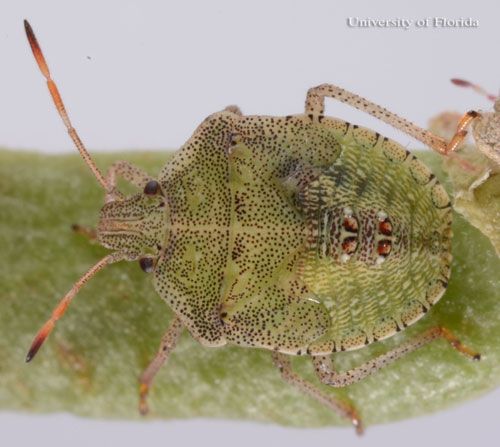
Credit: Lyle Buss, University of Florida
Life Cycle
Eggs are laid in clusters and are usually located on the underside of a plant's leaves. The incubation period can be anywhere from three days to three weeks depending on the environmental conditions. First instar nymphs remain on or near the eggs in clusters, and disperse to find water and food sources around the time of the first molt. Development from egg to adult ranges from two to four weeks, depending on environmental conditions and the host plant. Overwintering adults become active in spring, which is usually when the first generation appears. Euschistus quadrator is bivoltine, meaning it has two generations per year. Overwintering adults typically colonize spring vegetables, white clover, and other wild hosts.
Hosts
Euschistus quadrator, like other stink bugs, is highly polyphagous. It is found on weeds such as clover, vetch and other legumes, which are thought to be reproductive hosts. It feeds on many different crops, though it is primarily found on cotton, soybeans and corn. Both nymphs and adults use essentially the same hosts although adults will sometimes "feed" on plants that are not suitable hosts for development from egg to adult, so adults can sometimes have a broader "host" range.
Economic Importance
Stink bugs cause injury to various fruits and vegetables by feeding, resulting in significant quality and yield loss. They have piercing-sucking mouthparts and most feed primarily on fruits and seeds. Stink bugs pierce plant tissues with their stylets, causing physical damage that resembles a pinprick. They also inject digestive enzymes to aid in extracting the plant's fluids. This results in injury in the form of discolored spots on the fruit or deformed areas, rendering the fruit unmarketable. If no reproductive plant tissues are available, stink bugs will feed on the vegetative growth. Stink bug feeding can also alter the taste of the fruit.
Management
Stink bugs are very mobile, polyphagous pests, making monitoring and management difficult.
Monitoring
Visual searches, ground cloths, pyramid traps, blacklight traps, fruit injury counts, beating, and sweep net samples have historically been used to determine stink bug infestation levels.
Mizell and Tedders developed a pentatomid trap that is used extensively in pecan and peach orchards. These pyramid traps were shown to be most effective when painted with industrial safety yellow paint as opposed to other colors, indicating that the color yellow may be an attractive visual stimulus for stink bugs. For details, see Monitoring Stink Bugs with the Florida Stink Bug Trap.
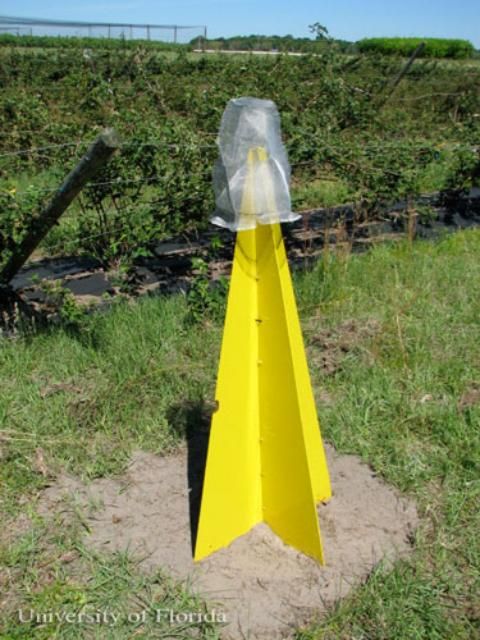
Credit: Sara Brennan, University of Florida
Yellow pyramid traps were shown to increase attraction when paired with the Euschistus spp. aggregation pheromone methyl (2E,4Z)-decadienoate, offering a more convenient and efficient method of monitoring compared to visual searches, sweep netting or insecticidal sprays.
Tube traps made from clear plastic tubes with wire mesh cones on the ends were used in several studies with varying results, and are still commercially available for monitoring stink bugs.
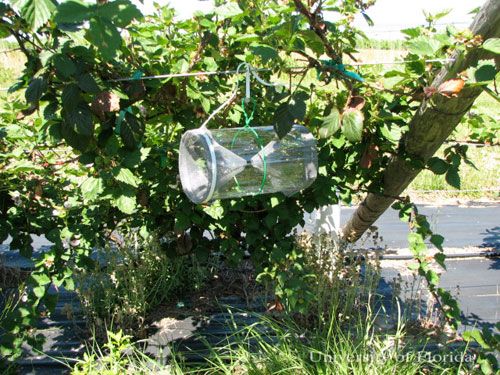
Credit: Sara Brennam, University of Florida
Cultural Control
Trap cropping may also be effective in reducing stink bug populations in economic crops. See Trap Crops for Management of Stink and Leaffooted Bugs.
Chemical Control
Currently the use of conventional insecticides, primarily synthetic pyrethroids, is the primary method for managing stink bug populations.
Florida Insect Management Guide for fruits and nuts
Florida Insect Management Guide for vegetables
Florida Insect Management Guide for field crops and pastures
Selected References
Aldrich JR, Hoffmann MP, Kochansky JP, Lusby WR, Eger JE, Payne JA. 1991. Identification and attractiveness of a major pheromone component for Nearctic Euschistus spp. stink bugs (Heteroptera: Pentatomidae). Environmental Entomology 20: 477–483.
Bundy CS, McPherson RM. 2000. Morphological examination of stink bug (Heteroptera: Pentatomidae) eggs on cotton and soybeans, with a key to genera. Annals of the Entomological Society of America 93: 616–624.
Buntin GD, Greene JK. 2004. Abundance and species composition of stink bugs (Heteroptera: Pentatomidae) in Georgia winter wheat. Journal of Entomological Science 39: 287-290.
Hopkins BW, Bernal JS, Knutson AE. 2005. Euschistus quadrator (Hemiptera: Pentatomidae): a new pest in lower Texas Gulf coast cotton. Proceedings of the Beltwide Cotton Conferences 2005:1480-1485. [Zool. Rec. Search, July 08].
Krupke CH, Brunner JF, Doerr MD, Kahn AD. 2001. Field attraction of the stink bug Euschistus conspersus (Hemiptera: Pentatomidae) to synthetic pheromone-baited host plants. Journal of Economic Entomology 94: 1500–1505.
McPherson JE, McPherson RM. 2000. Stink Bugs of Economic Importance in America North of Mexico. CRC Press, Boca Raton, Florida. 272 pp.
McPherson RM, Pitts JR, Newsom LD, Chapin JB, Herzog DC. 1982. Incidence of tachinid parasitism of several stink bug (Heteroptera: Pentatomidae) species associated with soybean. Journal of Economic Entomology 75: 783–786.
Mizell RF. (2008). Stink Bugs and Leaffooted Bugs Are Important Fruit, Nut, Seed and Vegetable Pests. ENY-718. Gainesville: University of Florida Institute of Food and Agricultural Sciences. https://edis.ifas.ufl.edu/IN534 (January 2017).
Mizell III RF, Tedders WL. 1995. A new monitoring method for detection of the stinkbug complex in pecan orchards. Proceedings of the Southeastern Pecan Growers Association 88: 36–40.
Leskey TC, Hogmire HW. 2005. Monitoring stink bugs (Hemiptera: Pentatomidae) in mid-Atlantic apple and peach orchards. Journal of Economic Entomology 98: 143–153.
Miles PW. 1972. The saliva of Hemiptera, pp. 183–255. In Beament JW, Treherne JE, Berridge MJ (editors). Advances in Insect Physiology, Volume 9. Academic Press Inc., New York, NY. 438 pp.
Orr DB, Russin JS, Boethel DJ, Jones WA. 1986. Stink bug (Hemiptera: Pentatomidae) egg parasitism in Louisiana soybeans. Environmental Entomology 15: 1250–1254.
Panizzi AR. 1997. Wild hosts of pentatomids: Ecological significance and role in their pest status on crops. Annual Review of Entomology 42: 99–122.
Rolston LH. 1974. Revision of the genus Euschistus in Middle America (Hemiptera, Pentatomidae, Pentatomini). Entomologica Americana 48: 1–102.
Schaefer CW, Panizzi AR. 2000. Heteroptera of Economic Importance. CRC Press, Boca Raton, Florida. 856 pp.
Tillman G, Lamb M, Mullinix Jr B. 2009. Pest insects and natural enemies in transitional organic cotton in Georgia. Journal of Entomological Science 44: 11–23.
Todd JW, Herzog DC. 1980. Sampling phytophagous Pentatomidae on soybean, pp. 438–478. In Kogan M, Herzog DC (editors), Sampling Methods in Soybean Entomology. Springer-Verlag, New York, New York. 587 pp.